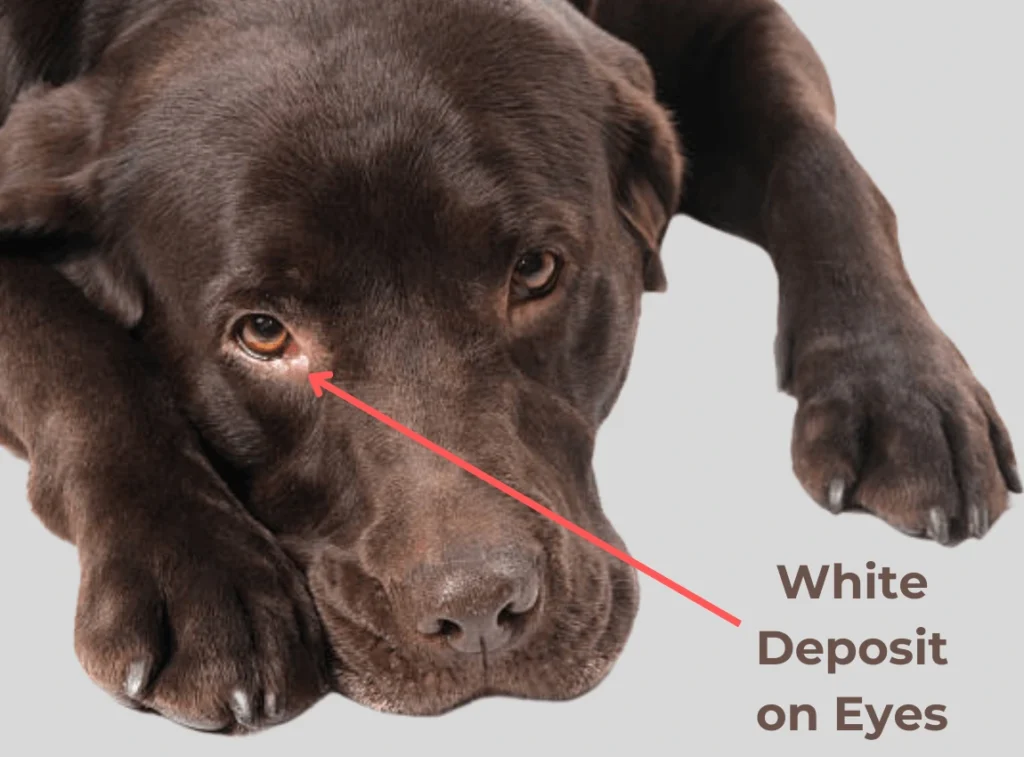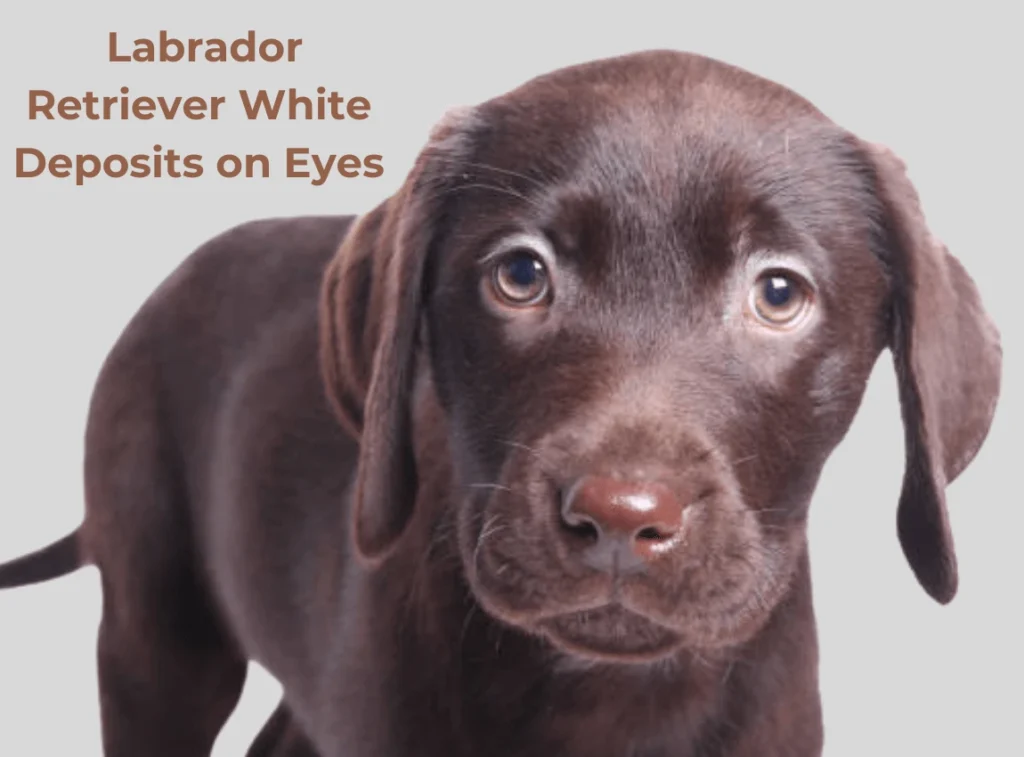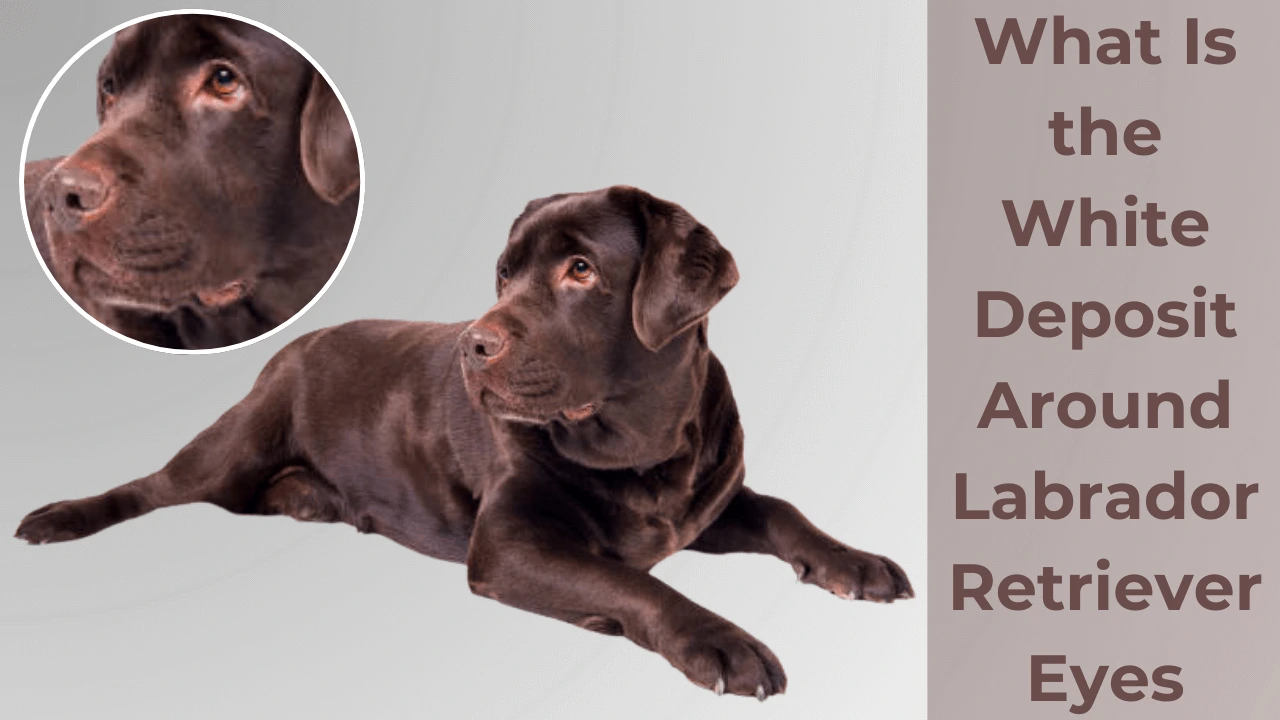White deposits around the eyes of Labrador Retrievers are a common problem experienced by many owners. This is usually caused by tear stains, dry secretions, or mucus buildup and can be caused by factors such as excessive tearing, allergies, or minor eye infections.
It is usually harmless but may also indicate an underlying condition such as blockage of the lacrimal gland or irritation from environmental factors. It is important to clean your Labrador Retriever eyes regularly to prevent the buildup of white deposits.
Use a soft, damp cloth or veterinarian-approved eye wipe to remove any residue. For more stubborn stains use a tear stain remover specifically formulated for dog breeds. Tidying the hair around the eyes also helps minimize deposits and moisture buildup.
In some cases, white deposits around the Labrador Retriever eyes may be a sign of a more serious problem such as an eye infection or allergic reaction. If the deposits persist or worsen, or are accompanied by redness, swelling or discomfort so consult your veterinarian immediately.

A healthy diet, adequate fluid intake, and regular veterinary visits can help prevent and manage this condition. Managing white deposits around your Labrador Retriever’s eyes will help maintain the health and overall comfort of your dog’s eyes.
- Understanding White Deposits around Labrador Retriever Eyes:
- 8 Causes of White Deposits around Labrador Retriever Eyes:
- 1. Normal tear fluid contamination and drainage:
- symptoms of drainage:
- 2. Conjunctivitis (pink eye):
- Causes of conjunctivitis:
- 3. Allergies:
- Allergy symptoms:
- 4. Dry eye syndrome:
- Symptoms of dry eye syndrome:
- 5. Infections:
- Common symptoms of eye infections:
- 6. Blocked tear ducts (Epiphora):
- Symptoms of blocked tear ducts:
- 7. Eye Injuries:
- What to watch for:
- 8. Medical problems:
- Indicate Eyes Problem:
- Treatment of White Deposits around Labrador Retriever Eyes:
- Tips for Managing and Preventing White Deposits around Labrador Eyes:
- Conclusion:
- Frequently Asked Question:
Understanding White Deposits around Labrador Retriever Eyes:
White deposits around your Labrador Retriever’s eyes can be worrisome but they are usually caused by a common, treatable problem. These deposits are usually dried tears, mucus, or skin discharge. Here’s what you need to know.

Tear stains:
White and light-colored Labradors can develop tear stains due to excessive tear production. When tears mix with bacteria and air they leave behind dog tear stains. Dogs with allergies, eye infections, or blocked tear test ducts may be more susceptible to this problem.
Eye infections and inflammation:
Infections or inflammation caused by dust, allergens, or foreign objects can increase tear production and mucus buildup. This can lead to the formation of hard white deposits around the eyes.
Dietary and environmental factors:
An unbalanced diet, dehydration, and exposure to environmental irritants can worsen tear staining and mucus formation.
Cleaning and care:
Regularly wiping your Labrador’s eyes with a soft, damp cloth will help prevent the buildup of eye secretions. Use veterinarian-approved cleaners and avoid harsh chemicals.
When to see the vet:
If white deposits persist, feel strange or are accompanied by redness, swelling, or discomfort so in this time contact your veterinarian. There may be an underlying medical condition in Labrador Retriever that needs treatment. With proper hygiene and regular checkups you can keep your Labrador’s eyes healthy and prevent white deposits.
8 Causes of White Deposits around Labrador Retriever Eyes:
The causes of white deposits around the eyes in Labradors dog range from benign to serious. The following are the most common causes.

1. Normal tear fluid contamination and drainage:
Tear production is a natural process that lubricates the dog’s eyes and removes debris. However, when tears are mixed with dirt, protein, or mucus a white or yellow discharge may occur. This is common in Labrador dogs.
symptoms of drainage:
- Active lifestyles and exposure to dust and environmental allergens.
- Has loose facial skin and coat and has a buildup of tears and excretions.
In most cases, this type of dog eye discharge is normal and can be resolved with regular grooming.
2. Conjunctivitis (pink eye):
Conjunctivitis is an inflammation of the eye conjunctiva, the tissue covering the eyelid and the white of the eye. Symptoms include eye redness, swelling, and discharge which may appear white, yellow, or green.
Causes of conjunctivitis:
- Allergies (pollen, dust, household chemicals, etc.)
- Bacterial or viral infections.
- Irritants such as smoke or shampoo.
If conjunctivitis is suspected consult your veterinarian for appropriate treatment such as eye drops or antibiotics.
3. Allergies:
As in humans, allergies can cause watery and runny eyes in Labradors. Common allergens include pollens, mites, moulds and some foods.
Allergy symptoms:
- Frequent eye twitching.
- Runny nose or runny nose.
- Red or itchy skin.
Allergy treatment involves identifying and removing triggers and using antihistamines or prescription medications if necessary.
4. Dry eye syndrome:
Dry eye syndrome occurs when there is insufficient tear production and the eyes are dry and irritated. When there are insufficient tears, mucus is secreted resulting in a white or sticky dog eye discharge.
Symptoms of dry eye syndrome:
- Frequent blinking and blinking of the eyes.
- Blurry or dull eyes.
- Redness and discomfort.
Treatment usually involves lubricating eye drops, prescription medications or in severe cases surgery.
5. Infections:
Eye infections caused by bacteria, viruses or fungi can cause significant discharge around the eyes. Infections often cause a yellow or green eye discharge, in milder cases a white film or crust dog may appear.
Common symptoms of eye infections:
- Swelling of the eyelids.
- Sensitivity to light.
- Behavioral changes such as reduced activity.
Immediate veterinary care is needed to treat infections and avoid complications.
6. Blocked tear ducts (Epiphora):
Blocked tear ducts prevent tears from draining properly causing them to overflow and accumulate around the eyes. Over time white or yellowish deposits may form.
Symptoms of blocked tear ducts:
- Constant wetness under the eyes.
- White spots on the fur around the eyes.
- Recurrent infections or irritation.
Your vet can flush the Schirmer tear test ducts to correct the problem of Labrador dog.
7. Eye Injuries:
Small scratches or foreign objects in the eye can cause irritation and discharge. Labradors are active dogs and may accidentally injure their eyes while playing or during outdoor activities.
What to watch for:
- Excessive blinking or yawning.
- Redness or swelling.
- Visible foreign objects in the eye.
If injury is suspected, avoid touching the eye and seek the help of a veterinarian immediately.
8. Medical problems:
Sometimes white deposits around the eye can indicate systemic health problems, e.g:
Indicate Eyes Problem:
- Autoimmune diseases: Autoimmune diseases such as pemphigus and similar conditions, can affect the skin around the eyes in some cases.
- Canine distemper virus: This is a rare but serious form of eye disease that causes dog eye discharge, fever and breathing problems.
- Glaucoma or cataracts: eye conditions that alter the production and outflow of tears.
Treatment of White Deposits around Labrador Retriever Eyes:
White deposits around the eyes of Labrador retrievers are usually caused by dry tears, mucus, and skin secretions. These deposits are usually harmless but with proper treatment and care the deposits can be contained and prevented.

Daily cleaning:
Regular cleaning is the most effective way to remove dog white deposits. Clean your eyes with a veterinarian-approved eye cleaner or use soft cloths or cotton that need to be wet thoroughly. Gently wipe the area around your Labrador’s eyes being careful not to rub hard enough to irritate the skin.
Address the underlying problem:
White deposits can indicate underlying problems such as:
| Problem | Description |
| Lacrimation | Excessive tearing usually caused by allergies or a blocked tear duct. If the lacrimation persists you should consult your veterinarian to determine if your dog breed needs treatment for an infection such as tear duct irrigation or antibiotics. |
| Eye inflammation or infection | If the tears are accompanied by redness, swelling, or discharge, you should consult your veterinarian. Antibiotics or anti-inflammatory eye drops can be applied. |
| Nutritional imbalances | Poor nutrition can worsen watery discharge eyes. To promote a dog’s eye health, you should provide a balanced diet rich in essential vitamins and minerals, especially omega-3 fatty acids. |
Maintain Hygiene around the Eyes:
Treat your Labrador with hair tucked into the eyes. This will keep her from getting dirt in and making you pet their eyes. Use blunt-tipped scissors and be careful not to injure your dog breed.
Hydration and environmental management:
Dehydration can make mucus production worse. So make sure your Labrador drinks plenty of fluids and has access to clean water. Avoid contact with dust, fumes, or allergens that can irritate the eyes.
When to see a veterinarian:
Contact your vet if deposits persist despite regular cleaning or if you notice additional symptoms such as redness, pain or changes in discharge behavior. Your vet will be able to diagnose the underlying condition and recommend appropriate treatment.
Consult your vet:
If the deposits persist or worsen, or are accompanied by redness, swelling or discomfort you should consult your vet. Your vet can perform a thorough examination to determine if there is a blockage, infection or other condition in the tear duct.
Tips for Managing and Preventing White Deposits around Labrador Eyes:
Maintaining your Labrador’s eye health requires ongoing care and attention. Here are some practical steps to prevent and manage cataracts:
Regular grooming:
- Gently wipe your dog’s eyes daily with a damp soft cloth or pet eye wipes.
- Trim excess fur around the eyes to minimize irritation and debris buildup.
Monitor your dog’s environment:
- To minimize allergen exposure keeping your home clean and well-ventilated is important.
- Don’t smoke or use strong-smelling products around your pet.
Provide a nutritious diet:
- For your Labrador’s overall health, feed a high-quality diet rich in omega-3 fatty acids and essential nutrients.
- Talk to your veterinarian about supplements like vitamin A or lutein for eye health.
Be careful with outdoor activities:
- Playtime supervision is recommended to minimize the risk of eye injury during play.
- Rinse your dog’s eyes with sterile saline after dusty or windy walks.
Schedule regular vet checkups:
- Regular veterinary visits help detect and address potential causes eye problems early.
- Talk to your veterinarian if you notice any changes in your dog’s behavior or appearance.
Also Read: https://thepetlive.com/labrador-retriever-puppy/
Conclusion:
White deposits around a Labrador Retriever’s eyes are usually caused by tear stains, excess mucus, or dry discharge. This is usually harmless but can be a sign of an underlying problem such as allergies, eye infection, or blocked tear ducts.
Regular cleansing and good hygiene can help manage and reduce white deposits. If the problem persists or is accompanied by additional symptoms it is important to consult a veterinarian for further diagnosis and require treatment.
By being proactive with eye care you can help your Labrador Retriever maintain optimal eye health without discomfort or irritation. Remember that early removal of white deposits around your Labrador Retriever’s eyes can prevent more serious complications in the future.
Frequently Asked Question:
Why is there white stuff around my dog’s eye?
White deposits around the dog’s eyes are often caused by tear stains, dry mucus or secretions. This may be due to allergies, infection or obstruction of the tear ducts.
How to treat dog calcium deposit in eye?
Calcium deposits in the eyes should be evaluated by a veterinarian. Treatment may include eye drops or surgery to remove the deposits, if necessary.
How do you get rid of white discharge from dogs’ eyes?
To remove the white discharge gently wipe the area with a damp cloth or use a veterinarian-approved eye cleaner to prevent further buildup.
What dissolves calcium deposits in the eye?
Calcium deposits can sometimes be treated with eye drops or other medications prescribed by your veterinarian to dissolve or manage the deposits.
Should I wipe my dog’s eye discharge?
For example gently wiping secretions from the dog’s eyes with a soft, damp cloth can help prevent deposits and irritation.
How do you get rid of white Labrador Retriever dog eye stains?
To remove white stains from the eyes use a special tear remover for dogs and keep the area clean and dry to prevent future stains.
What is the best eye cleaner for dogs?
The best cleaner for eye discharge is a gentle and non-irritating product designed especially for dogs. Look for brands recommended by veterinarians and with natural ingredients.










